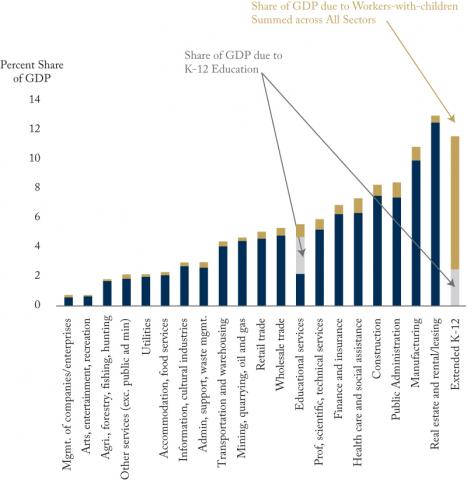From: David A. Green, Gaëlle Simard-Duplain, and Henry E. Siu
To: Policymakers across Canada
Date: January 27, 2021
Re: In-Person K-12 Schooling is Essential to the Canadian Economy
The extent to which K-12 schools should remain open remains at the forefront of discussions on long-term pandemic management.
Transmission and infection rates among children are lower than for adults. At the same time we understand the benefits of in-person schooling, and its crucial and multifaceted role in student well-being. Finding the right balance between in-person and online schooling remains important as Canada navigates its second wave of COVID-19.
In this debate, there has been little mention of the immediate importance of K-12 schooling for the rest of the economy. Depending on the sector of the economy, parents of school-aged children account for 6 to 22.5 percent of all workers. Eliminating in-person schooling reduces the amount of time parents have available to work, and therefore reduces income to those workers and the economy as a whole. Without the K-12 school system, it is hard to imagine how the modern work environment would function.
This makes preserving in-person schooling all the more important. We must stress that this does not mean that schools should remain open irrespective of public health conditions. Instead, it means we must continue to abide by our second-wave restrictions, so that schools can stay open for our physical, psychological, and material well-being.
To illustrate this, we discuss two measures of economic importance, and how they can be modified to better reflect the essential role played by K-12 education. The first measure of a sector’s importance is its size, as captured by the fraction of Canada’s GDP that is produced by that sector. The second reflects its centrality, how essential a sector is to economic activity. The economy is a network of activity, and sectors that produce goods and services used by other sectors – intermediate inputs – are more central to that network.
As conventionally measured, K-12 schooling is of limited importance. It represents less than 3 percent of GDP. Moreover, when the 98 sectors of economic activity are ranked from most to least central, it ranks near the bottom at 82nd.
But this does not account for the essential role of K-12 schooling in permitting parents to work. To address this, we consider a conceptual extension of the economy’s structure: we include a new “sector” that supplies the labour of parents of in-school children. We define those parents as lone parents, and one parent in a two-parent, two-income family. Other parents in two-earner families; those in two-parent, single-earner families; and individuals without school-aged children are not considered affected by school closures. This forms the basis of our extended measures of importance.
The bulk of Canadian GDP is earned in the form of labour income (as wages, salaries and benefits). We use the 2016 census to compute the share of labour income attributable to workers with children. This is the indirect contribution of K-12 education to GDP. The total contribution is the sum of its direct and indirect contributions. This is our extended measure of size.
Similarly, the extended centrality measure recognizes that the labour provided by workers with children serves as an intermediate input into all other sectors. In turn, the workers-with-children sector uses input from the rest of the economy, with K-12 schooling being an important one of these. This highlights the centrality of K-12 schooling – as an input into a sector that is itself a central sector for all others.
After applying the extension to the size measure, K-12 schooling accounts for 11.5 percent of GDP. As such, it is second only in size to real estate and rental and leasing. Furthermore, it ranks first in terms of centrality, ahead of all other sectors.
To summarize, K-12 schooling is crucial to the functioning of the national economy. By our more comprehensive measures, it supplants sectors that have figured prominently in deliberations regarding the economic consequences of the pandemic. Disruptions to K-12 schooling, more than disruptions to almost any other sector, compromise the economic well-being of Canadian families. This is particularly important given the unequal burden imposed by the need to homeschool children, both across families (especially low-income and single-parent families), and across parents within the same family (especially mothers). The economic importance of K-12 schooling adds to the already vital role it plays as a determinant of children’s psychological and social well-being.
David A. Green is Professor, Vancouver School of Economics, UBC, Gaëlle Simard-Duplain is a post-doctoral researcher, Centre for Innovative Data in Economics Research (CIDER), UBC, and Henry E. Siu is Professor, Vancouver School of Economics, UBC.
To send a comment or leave feedback, email us at blog@cdhowe.org.
The views expressed here are those of the authors. The C.D. Howe Institute does not take corporate positions on policy matters.
For details on methodology, data sources, and robustness checks, please see D. A. Green, A. Karimirad, G. Simard-Duplain, and H. E. Siu, “COVID and the Economic Importance of In-Person K-12 Schooling,” working paper, University of British Columbia.
This Memo first appeared in November 2020.






